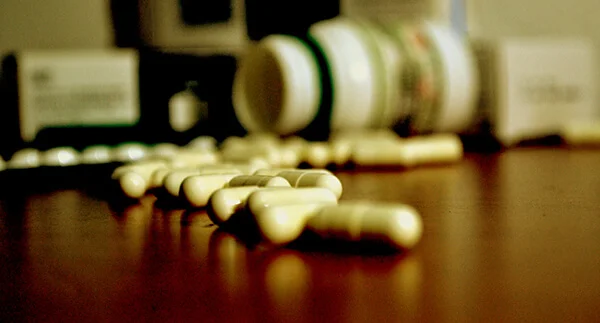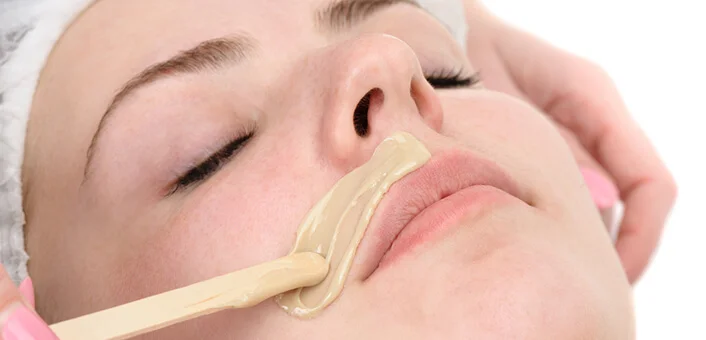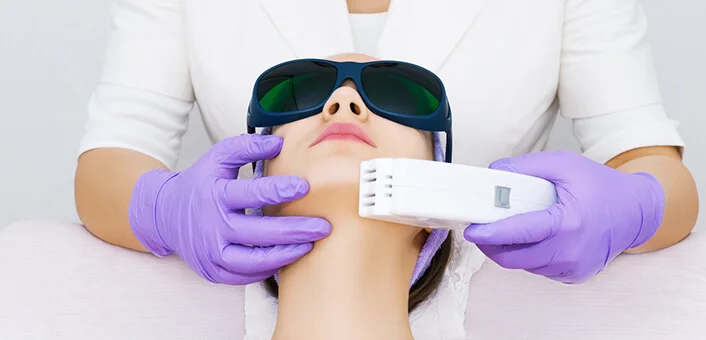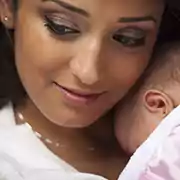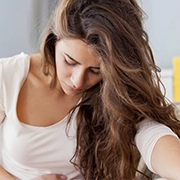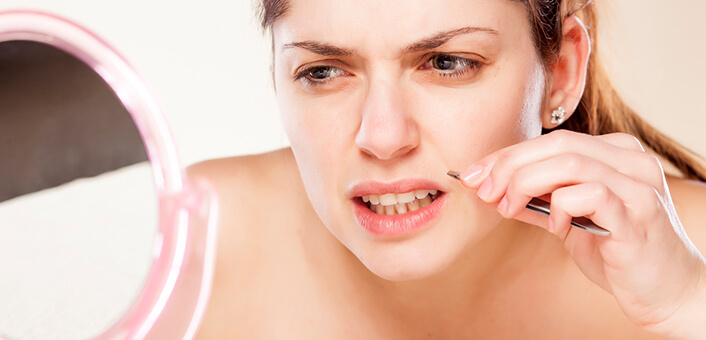
Polycystic Ovarian Syndrome
PCOS Hirsutism: Tips To Manage This Undesirable Condition
Oct 4, 2017Hirsutism or unwanted facial and body hair can make any woman feel unfeminine and undesirable. PCOS comes with a plethora of challenging symptoms. Infertility, unexplained weight gain and cystic acne can all wreak havoc on your life. But unwanted facial hair…that’s a whole different animal…one that’s rather hard to tame! Sadly, hirsutism is a common symptom of PCOS.
Patients start to notice thick, masculine pattern hair growth on their chin, along the jawline, around the mouth, arms, legs and torso. Women suffering from hirsutism can get very dissatisfied with their appearance. Some women even resort to obsessive hair removal practices because of the social pressure associated with this condition.
Getting rid of unwanted PCOS facial hair takes time and money. And it adds to the pain, frustration, social anxiety, mental distress, low self-esteem and self-doubt that often accompany PCOS and its many symptoms. So, why are women with PCOS dealing with thick, black ugly hairs growing in all manners of unusual spots. And what can be done about it?
PCOS and Hirsutism: What’s The Connection?
PCOS is caused due to hormonal imbalances. When a woman’s body produces excess androgens, or male hormones, hirsutism is a common side-effect.
One primary reason for PCOS facial hair is insulin resistance. The condition causes over-stimulation of pancreatic beta (β) cells, leading to excess insulin (or hyperinsulinemia). This signals the ovaries to produce more androgens, like testosterone. These excess androgens (or male hormones) then cause hormonal imbalance, which is what leads to PCOS. As is clear, these androgens that to be blamed for undesirable PCOS facial and body hair in women.
Scientists at University of Brescia, Italy set out to find how PCOS hirsutism and acne manifest in women. Their findings showed that Hirsutism was more closely associated with a greater incidence of obesity and insulin resistance. This study proves that excess PCOS facial hair is closely linked to insulin resistance and androgens, which turns the light, thin hair that usually covers a woman’s skin into thick, dark hair.
A study conducted at the University of California found that degree of hyperinsulinemia, independent of androgen levels, is an important factor in the severity of PCOS hirsutism. It’s not surprising that the researchers revealed that insulin has a direct effect on the severity of PCOS hirsutism in PCOS. Also, insulin appears to have a close interaction with total testosterone levels.
Treatment Options For PCOS Hirsutism
As you can imagine, dealing with unwanted facial and body hair is an on-going battle for many women with PCOS.
There are various strategies that you can use to manage PCOS facial hair. You can use them in varying combinations, depending on the severity of your problem, as discussed with your doctor. However, the key is addressing the underlying hormonal imbalance. Without that, you will be swimming against the tide, and your efforts will not be fruitful.
Medical Treatments For Hirsutism
There are medical treatments available to manage hirsutism involving drugs. These include:
- Androgen Blockers,
- Androgen Suppressors, and
- Androgen Inhibitors
Birth control pills, corticosteroids, and insulin-sensitizing agents like Metformin are all prescribed for treating hirsutism. Yasmin or Yaz is also very common. All of these “anti-androgens” come with side-effects and none should be taken during pregnancy. They take up to 6 months to show effective results. Know that these results will quickly disappear when you stop taking the drugs if you haven’t addressed the underlying causes of PCOS and hirsutism in the meantime.
Dietary Changes To Manage Hormonal Imbalances
The right dietary changes can reverse insulin resistance and hormonal imbalances, which lie at the heart of PCOS hirsutism. You can read more about choosing the right PCOS Diet in our detailed article, but some of the principles are:
- Eliminate all refined and processed foods from your diet
- Eat more fiber-rich vegetables and fruits, along with lean proteins
- Add healthy fats like grass-fed butter, coconut oil, ghee, extra-virgin olive oil, avocados, fatty fish, nuts and seeds to your diet
- Cut back on dairy
- Add gut-friendly probiotics to your diet
When coupled with regular exercise, these dietary changes are a long-term solution for improving insulin sensitivity, helping you lose weight, and managing excess PCOS facial hair.
At-Home Hair Removal Techniques
There are many ways to remove undesirable facial and body hair. You can choose a hair removal technique that best suits your needs. The techniques will vary depending on the area, the consistency of hair, the amount of growth, and your own personal preference. Your options are:
- Shaving
Shaving is the most popular method for removing unwanted facial and body hair. It’s easy, quick, pain-free and relatively inexpensive. While shaving works great for removing hair on arms and legs, it doesn’t work all that well for PCOS facial hair. This is because shaving results in a stubble regrowth, with hair that is less flexible, which feels more ‘bristly’.
- Bleaching
Bleaching lightens up hair, making it more invisible. This works great for the softer, less dense hair on face, chin and arms. You can use any over-the-counter bleach designed for women. Or you can make your own bleach by mixing up baking soda, household ammonia and 6% hydrogen peroxide. However, this is a time-consuming method. Also, bleaching doesn’t work well for women who have sensitive skin that’s easily irritated with chemicals. Also, bleaching may not be able to mask the thick, dark, wiry hairs that often come with PCOS hirsutism.
- Hair Removal Creams
Hair removal creams are another easy and cost-effective method for at-home hair removal. They work especially well for women who don’t want to use a razor, but want to remove excess hair from legs, arms and sensitive areas such as the face, underarms and bikini line. The alkaline chemicals in the cream break down hair so that it can be wiped off clean without ‘cutting’ or ‘plucking’ the hair, making this a pain-free method. Unlike shaving, the regrown hair is not stubbly or bristly. However, the chemicals in these creams can sometimes cause skin reactions, so it’s important to do a spot-test before full application.
- Waxing
Waxing literally ‘plucks’ out unwanted hair. And yes, it’s painful. Molten wax is applied to a patch of skin, and hair is plucked out with the help of a waxing strip. It can be a useful method to remove hair from larger area, like legs, arms, chest and back. This method is definitely faster than bleaching or hair removal creams. But it can be cumbersome if there’s a lot of hair to deal with, and it may be hard to reach some of the areas. This is why if you can afford it; choose to get your waxing done at a salon where a trained esthetician can make hair removal less painful in every sense of the word. Know that waxing can lead to ingrown hairs when used extensively in areas like the inner thigh and groin.
- Epilators
An electrical device that mechanically pulls out multiple hairs, an epilator is ideal for at-home use in-between your monthly waxing appointments at a salon. Epilators work similar to waxing and come in various designs at various price-points. Epilators can be painful, especially if you try using it on longer hair.
- Plucking & Tweezing
To maintain small patches with unwanted PCOS facial hair, at-home plucking and tweezing works well. It’s an easy way to remove stray hairs from eyebrows, upper lip, cheeks and chin. The process usually involves some pain, and a lot of accuracy. If you can afford to, visit a salon for professional ‘threading’ wherein an esthetician uses a thread to remove facial hair more quickly and more accurately.
Sadly, once wiry hair starts to grow in any area, it’s difficult to completely get rid of it with cosmetic at-home treatments. The hair may get lighter and less dense with time, but it will not go away for life, until you correct the underlying problem.
Professional Hair Removal Treatments
In severe cases where at-home hair removal techniques don’t work, you can seek professional treatments to get rid of unwanted PCOS facial hair. However, these treatments are expensive and require various sittings just to get rid of all excess facial hair – growing on chin, jawline, cheeks and upper lip. As you can imagine, you will need a different hair removal technique to address the excess hair growth on arms, legs, chest, back and torso because of the cost and time involved with these treatments.
- Laser Treatments
A beam of laser light is directed at hair follicle to damage the hair from the root, removing excess facial and body hair. While this method is more long-lasting than at-home or at-salon hair removal treatment, it costs a lot more and is not a permanent solution. Based on your hair regrowth, follow up sessions are needed. Laser treatments work better on less-dense lighter color hair.
- Electrolysis
Considered the gold standard for permanent and safe method of hair removal, electrolysis permanently destroys the hair follicle. A small needle is inserted into individual hair follicle to damage the hair from its root with a small electric current. It can be panful, can make your skin very irritated and sensitive, and can require various settings to get rid of all hair. It’s expensive and cannot guarantee no-regrowth if underlying hormonal imbalances are not corrected.
Natural and Holistic Treatments For PCOS Hirsutism
Along with dietary changes, some natural supplements can also improve androgen levels to treat the underlying causes behind PCOS facial hair from within.
- A study found that drinking two cups of spearmint tea can help lower testosterone levels in women with PCOS. While this study lasted only 30 days, you will need to continue drinking spearmint tea for much longer to see effective improvements in hirsutism.
- Flaxseeds can be effective for treating hirsutism and PCOS. A case study was conducted at Duke University Medical Center, Durham. The study followed the impact of flaxseed supplementation (30 g/day for 4 months) on hormonal levels in a 31-year old woman with PCOS. She reported a decrease in hirsutism at the completion of the study period.
- Saw Palmetto is another natural and holistic remedy for try out. It works as an androgen inhibitor by reducing 5 alpha-reductase (an enzyme that converts excessive testosterone into DHT) production. This makes it a useful herbal remedy for PCOS related hirsutism.
We believe that the best line of treatment for PCOS hirsutism is to make dietary changes coupled with natural supplements to see long-lasting results. These treatment techniques help cure the underlying causes – namely insulin resistance and hormonal imbalances. Bonus – they come without any unwarranted side effects. Since these treatment methods take time to show effective results, at-home hair removal techniques can be used for managing unwanted PCOS facial hair in the meantime.
PCOS Hirsutism: It Affects Your Quality Of Life
The healthcare community takes many symptoms of PCOS like infertility, acne, irregular periods and ovarian cysts very seriously. These symptoms are painful and distressing, but hirsutism also affects quality of life for women dealing with unwanted PCOS facial hair.
We live in a society where hairlessness is viewed as the norm for women. And this is why PCOS hirsutism in women results in significant psychological and social problems. The time and effort that goes into removing excess facial and body hair can feel overwhelming and frustrating. Sadly, the social, financial and emotional impacts of hirsutism can sometimes be overlooked.
There’s need for further research to understand this distressing problem. It’s important that clinicians and aestheticians treating women with PCOS facial and body hair deal with them sensitively, and acknowledge the psychological and emotional difficulties faced by these women.
Most current available treatments have limited effectiveness. Which is why it’s important to treat the underlying causes behind PCOS hirsutism. And if you are overwhelmed and frustrated, don’t be afraid to seek help.
Finding out that you have PCOD after suffering from its symptoms can be distressing, but the good news is that the condition can be reversed naturally using a holistic approach with Sepalika’s 5-Petal PCOD Programme. Our personalised protocols help treat PCOD at the root through diet, nutrition, exercise, Ayurveda and magnet acutherapy. What’s more, expert consults via phone and WhatsApp help you always stay on track in your journey to overcome PCOD.
References:
Management of Unwanted Facial Hair – https://www.skintherapyletter.com/fp/2011/7.2/3.html Acne and hirsutism in polycystic ovary syndrome: clinical, endocrine–metabolic and ultrasonographic differences – https://www.tandfonline.com/doi/abs/10.1080/gye.16.4.275.284 Degree of hyperinsulinemia, independent of androgen levels, is an important determinant of the severity of hirsutism in PCOS – https://www.sciencedirect.com/science/article/pii/S0015028208013058 Hirsutism and Quality of Life – https://link.springer.com/referenceworkentry/10.1007%2F978-0-387-78665-0_107 Spearmint herbal tea has significant anti-androgen effects in polycystic ovarian syndrome. A randomized controlled trial – https://www.ncbi.nlm.nih.gov/pubmed/19585478 The Effect of Flaxseed Supplementation on Hormonal Levels Associated with Polycystic Ovarian Syndrome: A Case Study – https://www.ncbi.nlm.nih.gov/pmc/articles/PMC2752973/ Inhibition of androgen metabolism and binding by a liposterolic extract of “serenoa repens B” in human foreskin fibroblasts – https://www.sciencedirect.com/science/article/pii/0022473184902644
